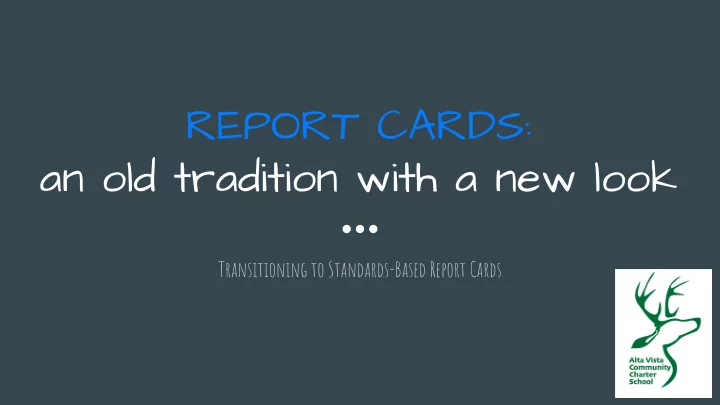

REPORT CARDS: an old tradition with a new look Transitioning to Standards-Based Report Cards
REPORT CARDS...they’re a lot of work, so why do we do them? To clearly, fairly, and objectively communicate how a child is ● progressing in school To help parents and students understand grade-level ● expectations and what is necessary achieve academic success To document a student’s academic progress, identifying areas ● of strength and areas of weakness To help teachers, schools, and districts improve instruction ●
SUBJECTS and STANDARDS SUBJECTS are broad categories Each SUBJECT has DOMAINS which are broken into of learning. In elementary grades, STANDARDS. core subjects include: Standards include . . . ● Reading/Language Arts ● end-of-year learning goals ● Mathematics ● concepts and skills to be mastered ● Science in each grade level. ● History/Social Science ● consistency and equity to ● PE/Health grade-level learning from ● Visual and Performing Arts classroom to classroom, school to school, district to district, and state to state.
TRADITIONAL GRADING vs. STANDARDS GRADING TRADITIONAL STANDARDS-BASED REPORT CARD REPORT CARD ● Provides a very limited measure of ● Measures students’ progress toward student abilities. An “A” in English/Language mastery of grade-level learning targets Arts feels great, but might not reveal by prioritizing the most recent or that a student who is an advanced reader consistent level of performance. is also struggling with writing conventions. ● Students are not penalized for mistakes ● Does not provide information on what a made at the beginning of the learning student should know or be able to do in process when concepts are new their grade level ● Provides details on student’s areas of ● Grades may be a reflection of different strength and weakness expectations among teachers, resulting in ● Separates academic progress from learning gaps from year to year work habits and behavior ● Raises questions about fairness and equity
STANDARDS, BENCHMARKS, and RATING SCALE STANDARDS are the end-of-year knowledge / skill goals for each subject in each grade level. Standards are listed on each grade level report card. BENCHMARKS break grade-level standards into learning targets. They are sub-sets of the knowledge / skills goals for each student to master by June. Measuring academic growth through benchmarks helps identify and remedy learning gaps as they arise. RATING SCALE is the term we use for the marks used in grading.
Former Grading Marks New Rating Scales Now, TK - 5 report academic Previously, grading marks were: progress using a 1-2-3 Rating Scale M : meets A : approaching N : not approaching The influence of work habits on student or learning is reported separately from academics, using the following marks: A: 90 - 100% B: 80 - 89% C: 70 - 79% D: 60 - 69% F: below 60%
For example... This highlighted example shows how a student might progress toward Mathematics standards throughout the school year. Note on the highlighted standard how DOMAIN it is possible for a student to be approaching standards (2) in STANDARDS Trimester 1 when the concept of Application of Strategies to Solve Word Problems was first introduced DOMAIN in simple terms. In Trimester 2, as more challenging STANDARDS learning targets in that subject are introduced, the student struggled and DOMAIN did not meet grade level standards (1). STANDARDS However, in Trimester 3, the teacher provided supports to the student DOMAIN where the benchmarks showed he was struggling and he finished STNDARDS Trimester 3 meeting grade level expectations (3).
What learning looks like in standards-based grading Quiz or Analyze Learn a Practice Project Make and fix new skill the skill on the mistakes mistakes skill Analyze e c A s t i k k e c a a f o M r r P and fix l l k i s s h k e e a e l p s t h m i t mistakes Demonstrate Mastery
NEXT STEPS: Talk with your child about the report card Talking with your child about the report card is an essential way to show them that you value their education and are committed to support their success. These points may help: Plan to talk in a quiet place and time when your child and you have each other’s ● complete attention. Talk about your child’s successes first. ● For disappointing marks, ask questions to understand how a score was earned. ● How difficult was the work? ○ Was extra help needed? ○ Would more active participation have made a difference? ○ Ask for a parent-teacher-student conference if you need more information. ● Set realistic goals and make a plan for improvement. ● Work together and follow through on your plan. ●
NEXT STEPS: WAYS TO SUPPORT YOUR CHILD 1. Stay in touch with your child’s teacher: sign up for Class Dojo, read their weekly newsletter, reach out to them when you have ideas, questions or concerns, and attend Parent Teacher Conferences. 2. Discuss what specific goals your child hopes to achieve this school year, and how. 3. Make time to ask your child about school day every day. Encourage them to share details about what was learned, what assignments due and how their progress toward goals is going. 4. Go over assignments, corrected papers and assessments with your child. 5. Set aside at least 20 minutes a day to read with your child. Whether reading a book together or just sitting together reading different things, show your child how much you value reading! 6. Help your child prep for projects / tests by reviewing directions, rubrics, study guides, and texts with them. Quiz them, asking wondering questions like “I wonder why that’s the right answer?” Students who can tell why an answer is right are more likely to have mastered the concept. 7. Send your child to school prepared with a positive attitude by making sure they have a restful night’s sleep, healthy breakfast, completed assignments, needed supplies, and of course YOUR POSITIVE ENCOURAGEMENT.
Recommend
More recommend